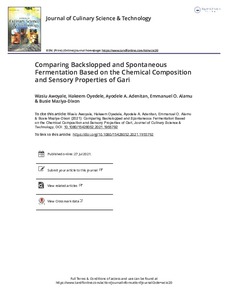| dc.contributor.author | Awoyale, W. |
| dc.contributor.author | Oyedele, H.A. |
| dc.contributor.author | Alamu, E.O. |
| dc.contributor.author | Maziya-Dixon, B. |
| dc.date.accessioned | 2021-08-18T13:04:40Z |
| dc.date.available | 2021-08-18T13:04:40Z |
| dc.date.issued | 2021-07-27 |
| dc.identifier.citation | Awoyale, W., Oyedele, H., Adenitan, A.A., Alamu, E.O. & Maziya-Dixon, B. Comparing backslopped and spontaneous fermentation based on the chemical composition and sensory properties of gari. Journal of Culinary Science & Technology, 1-17. |
| dc.identifier.issn | 1542-8052 |
| dc.identifier.uri | https://hdl.handle.net/20.500.12478/7211 |
| dc.description.abstract | The backslopped cassava mash (BCM) produced by pre-fermenting grated cassava for 96 h was mixed with fresh cassava mash from the same variety using different blend ratios and processed to backslopped fermented gari (BFG). Another batch of the same variety was fermented for 24 h, 48 h, 72 h, and 96 h to get spontaneous fermented gari (SFG). Standard methods were used to analyze the chemical composition and sensory properties of the samples. Results showed that the moisture, fat, and CNP contents, and the pH value of the 96 h SFG were significantly different (p < .05) from that of the BFG. The overall acceptability of the BFG was not significantly different (p > .05) from those of the 24 h and 72 h SFG. The information presented in this study may help the processors produce consistent quality gari for different end-users. |
| dc.description.sponsorship | Bill & Melinda Gates Foundation |
| dc.description.sponsorship | Department for International Development of the United Kingdom |
| dc.format.extent | 1-17 |
| dc.language.iso | en |
| dc.subject | Cassava |
| dc.subject | Garri |
| dc.subject | Spontaneous |
| dc.subject | Fermentation |
| dc.subject | Chemical composition |
| dc.subject | Organoleptic properties |
| dc.title | Comparing backslopped and spontaneous fermentation based on the chemical composition and sensory properties of gari |
| dc.type | Journal Article |
| cg.contributor.crp | Agriculture for Nutrition and Health |
| cg.contributor.crp | Maize |
| cg.contributor.crp | Roots, Tubers and Bananas |
| cg.contributor.affiliation | International Institute of Tropical Agriculture |
| cg.coverage.region | Africa |
| cg.coverage.region | West Africa |
| cg.coverage.country | Nigeria |
| cg.coverage.hub | Southern Africa Hub |
| cg.coverage.hub | Headquarters and Western Africa Hub |
| cg.researchtheme | Nutrition and Human Health |
| cg.identifier.bibtexciteid | AWOYALE:2021a |
| cg.isijournal | ISI Journal |
| cg.authorship.types | CGIAR Single Centre |
| cg.iitasubject | Aflatoxin |
| cg.iitasubject | Agronomy |
| cg.iitasubject | Cassava |
| cg.journal | Journal of Culinary Science & Technology |
| cg.accessibilitystatus | Limited Access |
| cg.reviewstatus | Peer Review |
| cg.usagerightslicense | Copyrighted; all rights reserved |
| cg.targetaudience | Scientists |
| cg.identifier.doi | https://dx.doi.org/10.1080/15428052.2021.1955792 |
| cg.iitaauthor.identifier | Wasiu Awoyale: 0000-0002-3635-1414 |
| cg.iitaauthor.identifier | Hakeem Oyedele: 0000-0001-5734-9156 |
| cg.iitaauthor.identifier | Alamu Emmanuel Oladeji: 0000-0001-6263-1359 |
| cg.iitaauthor.identifier | Busie Maziya-Dixon: 0000-0003-2014-2201 |
| cg.futureupdate.description | Volume and Issue number |
| cg.futureupdate.required | Yes |
| cg.futureupdate.duration | 3 Months |

